A visit to the city of Seville offers plenty to see, but if you have more than a few days in the area, there are also lots of interesting places to visit within a short hop of the city which make for interesting day trips.
1. Santiponce: The archaeological site of Italica

Just 10 km from Seville city centre and easily reached by car or train, lies a preserved Roman city, believed to be one of the first Roman settlement in Spain and a must for history lovers. Among the ruins you will find remarkable mosaics in some large excavated Roman villas and an impressive amphitheatre. You can also see the remains of a temple and some Roman baths.
In the town of Santiponce, where the archaeological site is located, there is a Roman-themed visitor centre with a reconstruction of a 2nd century AD Roman house, which is also worth a visit.
2. Ecija

In a survey run by the newspaper Diario de Sevilla Ecija, also known as “the frying pan of Andalucia” was nominated, by locals, as the most beautiful town in the province of Seville . The town dates back to around 8 BC and was subsequently conquered by the Romans and then the Moors, leaving behind them a town that is rich in architectural and archaeological sites including palaces, convents and churches.
Whilst in Ecija, be sure to try the “bizcochos Marroquies”, which are incredibly light sponge cakes traditionally made in the local convents.
Essentials:
• Iglesia de los Descalzos
• Palacio de Benameji
• Plaza de España
3. Carmona
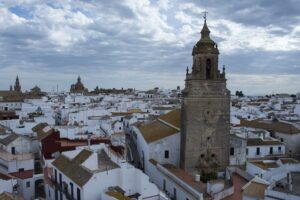 Only 30 kilometres from Seville lies the town of Carmona dating back to the Neolithic period, making it one of the oldest in mainland Europe. Rich prehistoric sites have been found in the surrounding area.
Only 30 kilometres from Seville lies the town of Carmona dating back to the Neolithic period, making it one of the oldest in mainland Europe. Rich prehistoric sites have been found in the surrounding area.
Occupied by the Romans their immense legacy and footprint are still very evident, including the town’s defensive gates and the Roman cemetery.
Carmona subsequently became the capital city of one of the Moorish kingdoms but was later reconquered by King Ferdinand III.
Carmona is a truly monumental city, making it one of the most important cultural and historical centres of the region.
Essentials:
• The Necropolis and Archeological area
• The Moorish Fortress and defensive gate
• The Market Square
• Santa Clara Convent
4. Estepa
Declared an Historic-Artistic Place of Interest in 1965, Estepa is famous for manufacturing sweets. The typical “mantecados” which are an essential part of Spanish Christmas, originate and are still manufactured in Estepa. Anyone with a sweet tooth, should take a visit to the factory or sample them in the bars and restaurants. Estepa is also home to one of
Europe’s biggest chocolate museums as well as a centre for the manufacture of Extra Virgin Olive Oil.
Despite being famous for its produce, Estepa is also a culture lovers delight with many monuments, churches and an old citadel dating back to the 11th century. For nature lovers, the countryside surrounding Estepa is well worth a visit, where you can see vast olive groves, rivers and mountains.
Essentials:
• Chocomundo Chocolate Museum
• Estepa castle
• El Gamo sweet factory
5. Osuna
 Picture postcard Osuna offers the visitor cobbled, narrow streets, white washed houses covered with Bougainvillea and 3,000 years of history to explore. Just under an hour from Seville, it makes Osuna a perfect day out from the city.
Picture postcard Osuna offers the visitor cobbled, narrow streets, white washed houses covered with Bougainvillea and 3,000 years of history to explore. Just under an hour from Seville, it makes Osuna a perfect day out from the city.
The town has featured in several TV series and films, including Game of Thrones and it now boasts its own Game of Thrones museum, for fans of the series.
Essentials:
• Wander round the beautiful streets
• The Bull ring and Game of Thrones Museum (for GOT fans)
• El Monasterio de la Encarnación
6. Cazalla de la Sierra
A beautiful town located in the stunning Sierra Norte Natural Park, Cazalla de la Sierra boasts mountains, meadows and forests. in an exceptional setting.
A nature lovers paradise, Cazalla also has a wealth of historical and religious buildings and monuments of different architectural styles dotted around the town.
Essentials:
• Walk or cycle the Greenway (via verde) of the Sierra Norte
• Take a self-guided or walking tour around the town to learn about the history.
7. Utrera
Located about 25 km from Seville, Utrera is considered to be the birthplace of flamenco as one of the birthplaces of some of the most world renowned flamenco artists. You can enjoy it for yourself in many of the local taverns. This is not flamenco for the tourists, but as it should be and has been for generations.
Narrow streets, whitewashed houses, palaces and churches, combine with olive trees, vineyards and farmhouses, giving Utrera its own unique personality. Utrera has its own train station, direct from Seville, so it makes a nice easy day trip from the city.
Essentials:
• Santuario de Nuestra Señora de Consolación
• Iglesia de Santa María de la Mesa
• A walk around the old town
8. Marchena
Dating back to 169 BC Marchena has come under the rule of various powers over the centuries. It is surrounded by agricultural lands of olive orchards and fields of cereal crops. It can be reached by train from Seville in just over an hour and is particularly worth visiting for the collection of art works by Francisco de Zurbarán, one of Spain’s most prominent 17th century artists, in the Museo de Zurbarán, situated within the Church of San Juan Bautista.
Essentials:
• Iglesia de San Juan Bautista
• Palacio Ducal
9. Lebrija
Sitting on the edge of the Guadalquivir River, Lebrija is surrounded by marshlands known as Las Marismas and vineyards. The city bears the mark of its Roman and medieval past. Wander through the streets explore its churches and mansions or different architectural styles. A small tower, named after the Giralda tower in Seville, which it resembles, stands out of the city skyline against the backdrop of the marshes.
Birthplace of the flamenco singer Juan Peña, ‘El Lebrijano’ and the pianist David Peña, Lebrija has acquired international fame with its own flamenco festival that takes place in the summer.
Essentials:
• Casa de la cultura
• Iglesia de Nuestra Señora de la Oliva
10. Parque Natural de Doñana
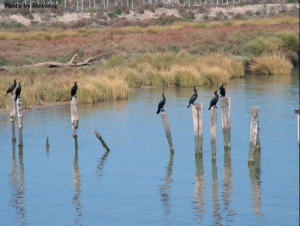 About an hour’s drive from Seville is one of the most important protected spaces in Andalucia, the Doñana National park, which is the largest ecological reserve in Europe.
About an hour’s drive from Seville is one of the most important protected spaces in Andalucia, the Doñana National park, which is the largest ecological reserve in Europe.
Boasting over 54,000 hectares, its combination of land and marsh ecosystems means it enjoys a unique biodiversity, where you can see species such as the Iberian Lynx and the Imperial eagle, both of which are in danger of extinction.
The park was dedicated a World Heritage Site in 1994 by UNESCO.
Related articles
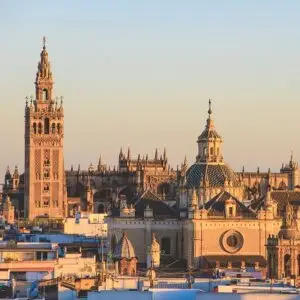
Top 10 places to visit in Seville
Seville could be described as a grand city. The architects of its cathedral are famed to have said “Let’s build
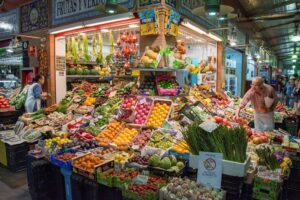
Hidden gems in Seville: off the tourist track
Seville, the sun-drenched capital of Andalucía, is famed for its flamenco, tapas, and stunning Moorish architecture. While landmarks like the
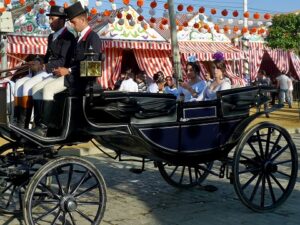
The vibrant fiestas of Seville: culture, tradition & joy
What truly sets Seville apart are its vibrant fiestas. These celebrations, deeply rooted in tradition, offer visitors a unique glimpse
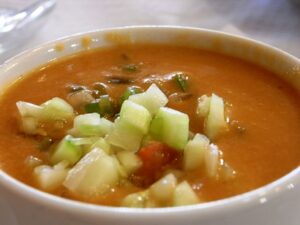
9 dishes typical of Seville that will make you say “Olé!”
When it comes to food, Seville’s gastronomy is a testament to its diverse cultural influences, blending Moorish, Jewish, and Christian
